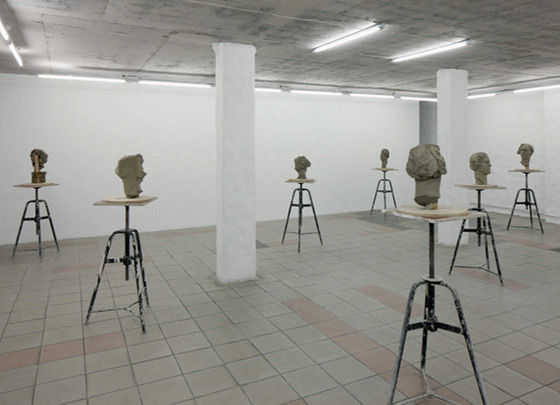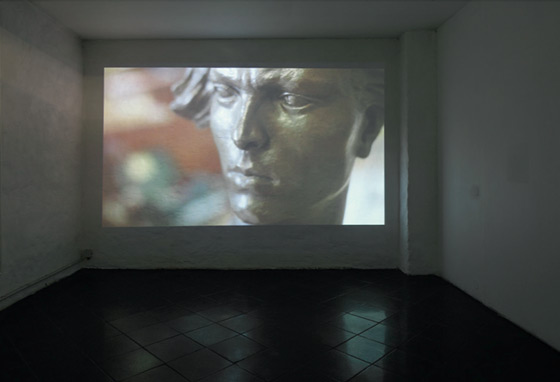|
|
| Marked point V back on the line Jana Kukaine, Art critic Review of Sanya Kantarovsky and Ella Kruglyanskaya’s Little Vera exhibition at kim? Contemporary Art Centre 13.07.–27.07.2014 | |
| The idea for the sculpture came from the creator of the Soviet pavilion, architect boris iofan. in accordance with his vision, a female and male figure, more than thirty metres high, raising a hammer and a sickle skywards in a celebratory gesture, had to be portrayed at one end of the pavilion. in the course of the competition, the construction proposed by mukhina was recognised as the best, and she described her own vision in this way: “i transformed the celebratory action of the [figures] into an all-crushing aspiration.”1 This aspiration, as well as the impression it left, was truly “all-crushing”. prior to the opening of the Little Vera exhibition, art historians Alise tīfentāle and christina kiaer presented lectures at the riga bourse Art museum, describing the action behind the scenes of the creation of the sculptural group. in their research, mukhina’s image is looked at not just from a historical, but also from the feminist angle, emphasising the sculptress’ atypical situation at the time, namely, she was able to create a career in the Soviet union, at least seemingly unconnected with the many restrictions, which included the “female theme” that in many cases defined the creative “ceiling” for female artists. on the contrary, it would be hard to imagine images more masculine than the ones done by mukhina. in 1943, she wrote the following in a short autobiography that was meant for an exhibition at the tretyakov gallery: “war has washed up heroes from the depths of the nation with an unseen wave, the portrayal of whom the artist can consider to be an honour.”2 it’s barely worth repeating that she consistently enjoyed the honour, creating countless memorials and portraits.3 that’s why, besides these great men and women, my attention was particularly drawn to some unexpected bas-relief from the “femino” theme created in 1932. its title, Bath at the Kindergarten, accurately describes what can be seen in the work, but with one exception – the female carer is pouring water over the naked children standing around her with a common watering can (unfortunately the work has not survived). what can you say – hurrah for the spirit of collectivism! Another story about Mukhina is revealed at the exhibition by Jānis Borgs, who emphasises a different aspect, namely, the intriguing issue of how mukhina was able to escape from Stalin’s fly catcher. in other words, her “bourgeois” origins, material security and western education were a sufficient pretext for repression by the totalitarian regime. And still, it didn’t happen. even (fabricated?) accusations against her husband were withdrawn. it could be said that mukhina enjoyed the benevolence of the party – she’d received the Stalin prize a number of times, which in those circumstances was a prize of the very highest level. The viewer can listen to Borgs’ narrative and at the same time view the exhibition’s performance. in it, nine young and budding sculptors from the Art Academy of latvia create copies of mukhina’s work The Partisan Woman, which can be found in the collection of the riga bourse Art museum. the video graphically shows how a defined image is created by combining visual and linguistic resources elicited from a shapeless (fact and myth) mass. furthermore, both women in this context – the partisan and mukhina – sort of merge into a single entity. yet – and here artist Sanya kantarovsky’s (Саня Кантаровский) great plan is revealed – the feature of the created copy is that it reveals only one perspective of the sculpture, the one that the specific sculptor has seen at the particular moment from his/ her angle. in this way the work generates fragmentary, pluralistic knowledge that can be contrasted with the universal, dominating opinion. however – by accident or design – this postmodern rhetoric is still not enough, as it seems (i haven’t yet verified these suspicions) that the unbaked clay creations seen at kim? won’t be very long-lasting; a few days after the opening, noticeable cracks had already begun to appear in the heads. the objections of art history, of course, are exactly the opposite – it tries to reach clarity, to gain a comprehensivenotionandtoleavesomethinglasting.thisappliesequallyto biographers as well as researchers and scholars of particular periods of art and ironically also includes those who have taken part in some way or another in the creation of the Little Vera exhibition. | |
 View from Sanya Kantarovsky and Ella Kruglyanskaya‘s Little Vera exhibition. 2014 Photo: Ansis Starks Publicity photo Courtesy of the artists and kim? Contemporary Art Centre | |
| “Marking the anniversary” and “the riga-born artist” are small, didactic transgressions that even the kim? centre wasn’t able to fight against this time. At one time kim? roamed fairly distant aesthetic plots, showing scant interest in educational tone or anniversary spreads decorated with dressed herring, “false hare” meatloaf and napoleon pastry. vera mukhina’s success hasn’t, of course, become more significant due to 125 years having passed since the day the sculptress was born, but this year is nevertheless important for the legend and for mukhina herself. more accurately, this status unequivocally suits the great mukhina. does the exhibition Little Vera tend to deconstruct this legend or, rather, to construct it anew, using contemporary means of expression? It seems that, in itself, the kim? centre is like a living continuator of mukhina’s biography, because her family once owned properties in the Spīķeri neighbourhood, where the art centre is located today. mukhina was born in riga into a rich merchant’s family, and a commemorative room to the sculptress has now been set up in her family’s former home at turgeņeva iela 23/25. it is significant that, in the interests of her own safety, she gave up all of her properties 1937, but the romantic atmosphere of this part of her life story remains. A second significant, though not completely verifiable, elemen of mukhina’s biography is that she defended kārlis zāle’s freedom momument in 1945 at the latvian SSr council of people’s commissars, thereby saving it from being demolished. mobilising at least some proportion of the heavy artillery of patriotism for the interpretation of this event, we gain a slightly pathetic image of mukhina that is well understood by the residents of a small baltic nation. Looking at it from the angle of paris, we should remember (the word “remember” is used here figuratively, as neither the author of the article nor, most likely, its possible reader has experienced this event) the 1937 world fair, at which mukhina’s best known work, Worker and Kolkhoz Woman, was a great success, the crown of the Soviet union pavilion. yes, we weren’t in paris that year, but we have seen films from the Mosfilm film Studio and know that the monument to Soviet ideology has been used as a peculiar studio emblem since 1947. it’s true that its dark colours perhaps didn’t really go together that well with the bright future that communism promised, but this may possibly have been the most trivial of the contradictions that reigned within society at that time.... | |
 View from Sanya Kantarovsky and Ella Kruglyanskaya‘s Little Vera exhibition. 2014 Photo: Ansis Starks Publicity photo Courtesy of the artists and kim? Contemporary Art Centre | |
| Six posters can be seen at the exhibition, the creation of which was supervised by artist ella kruglyanskaya (Элла Круглянская). Six quotes from various articles by mukhina (that same 1960 publication!) are included in them, and these are supplemented by drawings that refer stylistically to the graphic design of the 1950s and 1960s (this kind of trend, as noted by kruglyanskaya, is a characteristic of her creative work). this was a time when mukhina had already passed away, but memories of these years still remain in the minds of many people as an authentic Soviet-era experience. And here a certain moment of surprise, if not amazement, comes about – there’s a completely different mukhina in these selected quotations! She is playful and even mischievous, with an effervescent sense of humour. She talks about Aladdin’s lamp and the need to focus attention on the gathers in clothing, as this assists in the rendering of a person’s character more accurately. it seems fairly strange to accept that this is the same person who wrote the previously quoted lines “...from the depths of the nation with an unseen wave” and so on about war. in every respect a shining example from the selection! in a similar way as tīfentāle, kiaer and borgs constructed mukhina using the instruments of art history and theory and as the academy’s sculptors modelled her in malleable clay, so kruglyanskaya does the same, breaking down mukhina’s texts and putting them back together anew. The exhibition’s name – a reference to the 1988 film Little Vera directed by vasili pichul – is like a last postmodern gesture as well as a deft combinative exercise. the film is considered to be a promulgator of the perestroika spirit and a predictor of the Soviet union’s decline. the film also included vivid sex scenes, something that had been unimaginable up until that time in Soviet cinematography. After the release of the film, the actress who played the leading role, natalya negoda, became a sex symbol and was also the first Soviet actress to be photographed by Playboy magazine. And here one can fantasise about what both of the veras – the sculptress with her fairly severe expression and monumental stance (this impression was reinforced by the military fashion of the time) and the young woman with shaggy hair and garish lipstick – could have in common...or not. the significant thing probably is that they are linked (and at the same time separated) by being points at opposite ends of the ideological line from the same era; mukhina’s Worker and Kolkhoz Woman marked the culmination of Soviet propaganda, whereas the film Little Vera marked the decline of this very same propaganda. And this is already a time about which we could use the term “remember” in the literal sense. the graņonka glasses, too, can still be purchased without any problem at many antique shops in riga. Translator into English: Uldis Brūns 1 Мухина, Вера. Письмо в редакцию. В кн.: Мухина. Т. 1: Литературно-критическое наследие. Подбор текстов Р. Я. Аболиной. Москва: Искусство, 1960, с. 112. the letter from which this characterisation has been taken was published in 1938 (Архитектурная газета, No 12). 2 Мухина, Вера. Автобиография. В кн.: Мухина, т. 1, с. 9. 3 it’s true that we should take into account that the album dedicated to mukhina’s creative work, which is currently in my possession, came out in 1960, and i concede that its compiler had his/her own interests. for example, the 1920s, when mukhina worked in fashion design in paris, are not included in the overview. the fact of the legendary graņonka glass created by mukhina in 1943, with its 16 polished sides, has also been left out, possibly because this item wasn’t considered a design object worthy of particular note, whereas the elegant glass vases and dish sets corresponded to “high” criteria and are included in the “decorative Art” section of the publication. | |
| go back | |







